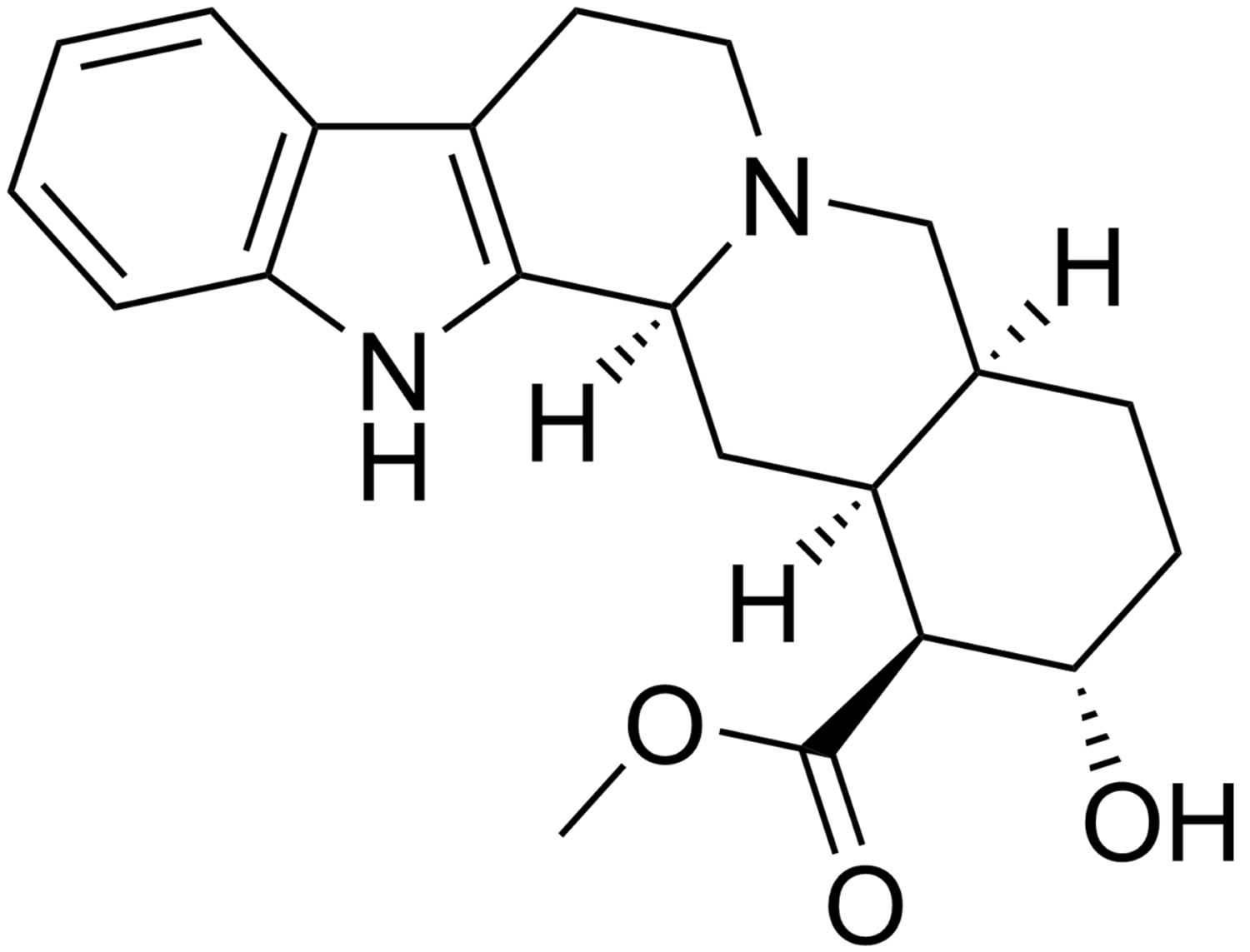What is rauwolscine
Rauwolscine is also called alpha-yohimbine, is a plant alkaloid with alpha-2-adrenergic blocking activity (α2-adrenergic receptor antagonist) that increases brain noradrenaline cell firing and release 1. In psychiatric research, yohimbine is the most commonly used pharmacological stressor, because it induces anxiety and stress-like responses in humans, monkeys, dogs, and rodents 2; yohimbine also induces heroin and alcohol craving in drug addicts 3. Yohimbine presumed stress-related mechanism of action is blockade of presynaptic alpha-2 adrenoceptors in noradrenergic cell body regions (locus coeruleus, lateral tegmental nuclei), resulting in increased brain noradrenaline cell firing and release in terminal areas 2. Based on this literature, and the finding that alpha-2 adrenoceptor block, which decrease noradrenaline cell firing and release, intermittent footshock stress-induced reinstatement of drug seeking 4. A decade ago three laboratories determined yohimbine’s effect on reinstatement of drug seeking 5. Lee et al. 6 found that yohimbine an alpha-2 adrenoceptor blocker reinstates cocaine seeking in monkeys, an effect associated with increased plasma levels of the stress hormone cortisol and species-typical stress-related behaviors. Alpha-2 adrenoceptors are known to be involved in stress-induced reinstatement of heroin and cocaine seeking in laboratory animals. Results indicate that activation of alpha-2 adrencoceptors is involved in both stress-induced reinstatement of alcohol seeking and alcohol self-administration. Shepard et al. 7 and Le et al. 5 found that yohimbine reliably reinstates methamphetamine and alcohol seeking in rats, mimicking the effect of intermittent footshock stress on reinstatement.
Figure 1. Rauwolscine (alpha-Yohimbine)
Subsequent studies provided additional evidence to support the notion that, yohimbine induces a stress-like state that leads to reinstatement of drug seeking. Both intermittent footshock- and yohimbine-induced reinstatement are critically dependent on activation of extrahypothalamic corticotropin-releasing factor 8. Both intermittent footshock and yohimbine increase resistance to extinction of drug seeking when administered prior to the daily extinction sessions 9. Both intermittent footshock and yohimbine increase levels of the stress hormone cortisol; yohimbine also induces stress-like responses in the rat social interaction test that are reversed by a corticotropin-releasing factor 1 receptor blocker 10. Based on these findings, and the findings that the effect of yohimbine on reinstatement of heroin and cocaine seeking in laboratory animals, yohimbine has recently become the most commonly used stressor in studies on reinstatement of drug or food seeking 11.
Dieting in the human condition has two main components, abstaining from consumption of unhealthy foods and consuming a limited amount of nutritionally balanced foods for sustenance. Generally speaking, humans with unhealthy eating habits consume limited amounts of nutritionally balanced foods and greater amounts of calorically dense palatable foods. It’s been shown yohimbine potently reinstates food seeking and also increases alcohol and food self-administration 12, 13. Unlike intermittent footshock, yohimbine’s effect on reinstatement of food and cocaine seeking is not blocked by the alpha-2 adrenoceptor agonist clonidine 14.
- Characterization of hippocampal norepinephrine release as measured by microdialysis perfusion: pharmacological and behavioral studies. Abercrombie ED, Keller RW Jr, Zigmond MJ. Neuroscience. 1988 Dec; 27(3):897-904. https://www.ncbi.nlm.nih.gov/pubmed/3252176/[↩]
- Noradrenergic mechanisms in stress and anxiety: I. Preclinical studies. Bremner JD, Krystal JH, Southwick SM, Charney DS. Synapse. 1996 May; 23(1):28-38. https://www.ncbi.nlm.nih.gov/pubmed/8723133/[↩][↩]
- Pharmacologically induced alcohol craving in treatment seeking alcoholics correlates with alcoholism severity, but is insensitive to acamprosate. Umhau JC, Schwandt ML, Usala J, Geyer C, Singley E, George DT, Heilig M. Neuropsychopharmacology. 2011 May; 36(6):1178-86. https://www.ncbi.nlm.nih.gov/pmc/articles/PMC3077446/[↩]
- Alpha-2 adrenergic receptor agonists block stress-induced reinstatement of cocaine seeking. Erb S, Hitchcott PK, Rajabi H, Mueller D, Shaham Y, Stewart J. Neuropsychopharmacology. 2000 Aug; 23(2):138-50. https://www.ncbi.nlm.nih.gov/pubmed/10882840/[↩]
- Role of alpha-2 adrenoceptors in stress-induced reinstatement of alcohol seeking and alcohol self-administration in rats. Lê AD, Harding S, Juzytsch W, Funk D, Shaham Y. Psychopharmacology (Berl). 2005 May; 179(2):366-73. https://www.ncbi.nlm.nih.gov/pubmed/15551068/[↩][↩]
- Pharmacological blockade of alpha2-adrenoceptors induces reinstatement of cocaine-seeking behavior in squirrel monkeys. Lee B, Tiefenbacher S, Platt DM, Spealman RD. Neuropsychopharmacology. 2004 Apr; 29(4):686-93. https://www.ncbi.nlm.nih.gov/pubmed/14872205/[↩]
- The anxiogenic drug yohimbine alpha-2 adrenoceptor blocker (antagonist) reinstates methamphetamine seeking in a rat model of drug relapse. Shepard JD, Bossert JM, Liu SY, Shaham Y. Biol Psychiatry. 2004 Jun 1; 55(11):1082-9. https://www.ncbi.nlm.nih.gov/pubmed/15158427/[↩]
- Role of corticotropin-releasing factor in the median raphe nucleus in yohimbine-induced reinstatement of alcohol seeking in rats. Lê AD, Funk D, Coen K, Li Z, Shaham Y. Addict Biol. 2013 May; 18(3):448-51. https://www.ncbi.nlm.nih.gov/pmc/articles/PMC3288693/[↩]
- Effects of repeated yohimbine on the extinction and reinstatement of cocaine seeking. Kupferschmidt DA, Tribe E, Erb S. Pharmacol Biochem Behav. 2009 Jan; 91(3):473-80. https://www.ncbi.nlm.nih.gov/pubmed/18824018/[↩]
- The CRF1 receptor antagonist antalarmin attenuates yohimbine-induced increases in operant alcohol self-administration and reinstatement of alcohol seeking in rats. Marinelli PW, Funk D, Juzytsch W, Harding S, Rice KC, Shaham Y, Lê AD. Psychopharmacology (Berl). 2007 Dec; 195(3):345-55. https://www.ncbi.nlm.nih.gov/pubmed/17705061/[↩]
- The use of the reinstatement model to study relapse to palatable food seeking during dieting. Calu DJ, Chen YW, Kawa AB, Nair SG, Shaham Y. Neuropharmacology. 2014 Jan; 76 Pt B():395-406. https://www.ncbi.nlm.nih.gov/pmc/articles/PMC3785569/[↩]
- Role of a genetic polymorphism in the corticotropin-releasing factor receptor 1 gene in alcohol drinking and seeking behaviors of marchigian sardinian alcohol-preferring rats. Ayanwuyi LO, Carvajal F, Lerma-Cabrera JM, Domi E, Björk K, Ubaldi M, Heilig M, Roberto M, Ciccocioppo R, Cippitelli A. Front Psychiatry. 2013; 4():23. https://www.ncbi.nlm.nih.gov/pmc/articles/PMC3624086/[↩]
- Cluster and meta-analyses on factors influencing stress-induced alcohol drinking and relapse in rodents. Noori HR, Helinski S, Spanagel R. Addict Biol. 2014 Mar; 19(2):225-32. https://www.ncbi.nlm.nih.gov/pubmed/24589296/[↩]
- Interaction between noradrenaline and corticotrophin-releasing factor in the reinstatement of cocaine seeking in the rat. Brown ZJ, Tribe E, D’souza NA, Erb S. Psychopharmacology (Berl). 2009 Mar; 203(1):121-30. https://www.ncbi.nlm.nih.gov/pubmed/18985323/[↩]





